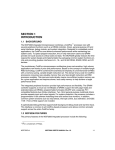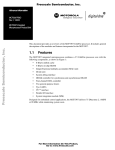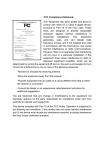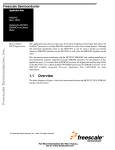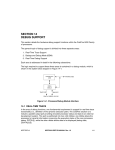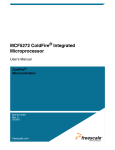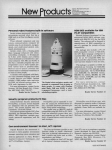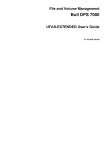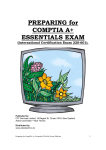Download MCF5307 - DigChip
Transcript
Order this document by
MCF5307/D
REV 0.0
Consumer Systems
Group
Communications
and Advanced
Consumer Technologies Group
MCF5307
Product Brief
MCF5307 Integrated ColdFire® Microprocessor
Overview
Introduction
The MCF5307 integrated microprocessor combines a ColdFire® processor core
with the following components:
• 8K unified cache
• Multiply-Accumulate (MAC) unit and Divide unit
• DRAM controller
• DMA controller
• Timers
• M-Bus (I2C)1
• Parallel and serial interface
• System integration unit
Designed for embedded control applications, the ColdFire core delivers enhanced
performance (70 MIPS) while maintaining low system costs.
Performance boosts are supplied to the clock-doubled core through the on-chip, 8
Kbyte unified cache and 4K SRAM, which provide pipelined, single-cycle access
to critical code and data.
The integrated Multiply-Accumulate (MAC) module enhances the device’s
functionality through support of high-speed, complex arithmetic operations. The
MAC supports instruction issue rates of 1 multiply-accumulate per cycle for
16x16 operations, and also performs 32x32 operations, all producing a 32-bit
result.
The MCF5307 processor greatly reduces the time required for system design and
implementation by packaging common system functions on chip and providing
glueless interfaces to 8-, 16-, and 32-bit DRAM, EDO DRAM, SDRAM, SRAM,
ROM, FLASH, and I/O devices.
1 I2C
is a proprietary Philips bus.
This document contains information on a product under development. Motorola reserves the right to change or discontinue this product without notice.
SEMICONDUCTOR PRODUCT INFORMATION
1997 Motorola, Inc. All Rights Reserved.
Overview, Continued
ColdFire Architecture
Provides New Price/
Performance Levels
The revolutionary ColdFire microprocessor architecture gives cost-sensitive,
high-volume markets new levels of price and performance. Based on the
concept of variable-length RISC technology, ColdFire combines the
architectural simplicity of conventional 32-bit RISC with a memory-saving,
variable-length instruction set. In defining the ColdFire architecture for
embedded processing applications, Motorola incorporated RISC architecture
for peak performance and a simplified version of the variable-length
instruction set found in the M68000 Family for code density.
Clock-Doubled
Version 3 Core Boosts
Performance
The MCF5307 is the first of the ColdFire Family to contain the Version 3,
clock-doubled ColdFire microprocessor core. Increasing the internal speed of
the core allows higher performance while providing the system designer with
an easy-to-use external system interface.
ColdFire VL RISC
Offers Many
Advantages
By using a variable-length instruction set architecture, embedded system
designers using ColdFire RISC processors will enjoy significant advantages
over conventional fixed-length RISC architectures. The denser binary code for
ColdFire processors consumes less valuable memory than any fixed-length
instruction set RISC processor available. This improved code density means
more efficient system memory use for a given application, and requires
slower, less costly memory to help achieve a target performance level.
The MCF5307
Integrates a Rich Set
of Modules with the
ColdFire V3 Core
The integrated peripheral functions provide high performance and flexibility.
The DRAM controller can interface with up to 256 Mbytes of DRAM and
supports bursting, page-mode, EDO and synchronous DRAMs.
Serial communication channels are provided by two programmable fullduplex UARTs and an M-Bus (I2C interface-compatible) module. Four
channels of DMA allow for fast data transfer using a programmable burst
mode independent of processor execution. The two 16-bit general-purpose
multimode timers provide separate input and output signals. For system
protection, the processor includes a programmable 16-bit software watchdog
timer. In addition, common system functions such as chip-selects, interrupt
control, bus arbitration, and an IEEE 1149.1 JTAG module are included.
A sophisticated debug interface supports background-debug mode and realtime trace, with on-chip breakpoint registers accessible from an emulator or
the processor itself. This interface is present in all ColdFire-based processors
and allows common emulator support across the entire ColdFire Family.
2
MCF5307 Product Brief
MOTOROLA
MCF5307 Features
ColdFire Processor
Core
• Variable-length RISC, clock-doubled Version 3 microprocessor core
• Independent 4-stage instruction and 2-stage operand pipelines
• 8-instruction FIFO buffer to provide decoupling between the pipelines
• Branch acceleration unit for increased performance
• 32-bit internal address bus with up to 4 Gbytes of linear address space
• 32-bit data bus
• 16 user-accessible, 32-bit-wide, general-purpose registers
• Supervisor / User modes for system protection
• Vector base register to relocate exception-vector table
• Optimized for high-level language constructs
• Hardware Integer Divide Unit
Multiply and
Accumulate Unit
• Provides high-speed, complex arithmetic processing for DSP
8 Kbyte Unified Cache
• Four-way set associative organization with writethrough and copyback
modes
• Operates at microprocessor core speed
• Provides single-cycle access to critical code and data
4 Kbyte SRAM
• Programmable location within 4 Gbyte linear address space
• Provides pipeline single cycle access to critical code and data
• Information stored in SRAM not affected by RESET instruction
DMA Controller
• Four fully programmable channels
• Supports dual-address and single-address transfers with 32-bit data
capability
• Two address pointers per channel that can increment or remain constant
• 16-bit transfer counter per channel
• Operand packing and unpacking supported
• Auto-alignment transfers supported for efficient block movement
• Supports bursting and cycle steal
• Provides two clock-cycle internal access
DRAM Controller
• Supports up to 512 Mbytes of DRAM
• Programmable refresh timer provides CAS-before-RAS refresh
• Support for two separate memory banks
• Support for EDO DRAMs and synchronous DRAMs
• Support for external masters
MOTOROLA
applications
• 1 clock issue rate with 3-stage execute pipeline
• Supports 16x16 and 32x32 multiplies, all with 32-bit accumulate
MCF5307 Product Brief
3
MCF5307 Features, Continued
2 UARTs
• Full duplex operation
• Flexible baud-rate generator
• Modem control signals available (CTS, RTS)
• Processor-interrupt capability
Dual 16-Bit GeneralPurpose Multimode
Timers
• 8-bit prescaler
• Timer input and output pins
• Processor-interrupt capability
• 22 ns resolution at 45 MHz
Motorola Bus
(M-Bus) Module
• Interchip bus interface for EEPROMs, LCD controllers, A/D converters,
keypads
• Fully compatible with industry-standard I2C Bus
• Master or slave modes support multiple masters
• Automatic interrupt generation with programmable level
System Interface
• Glueless bus interface with chip selects and DRAM controller support for
interface to 8-, 16-, and 32-bit DRAM, SRAM, ROM, FLASH, and I/O
devices
• 8 chip-select signals; 2 that are fully programmable with base address
registers, 6 at a fixed offset off the chip-select base address register
• Programmable wait states and port sizes
• User-defined bus speed @ 1/2, 1/3, or 1/4 of processor clock
• Programmable interrupt controller
• Low interrupt latency
• 4 external interrupt request inputs
• Programmable autovector generator
• 16-Bit general-purpose I/O interface
• IEEE 1149.1 test (JTAG) module
System Debug Support
• Real-time trace for determining dynamic execution path
• Background debug mode (BDM) for debug features while halted
• Real-time debug support, including three user-visible hardware breakpoint
registers
4
MCF5307 Product Brief
MOTOROLA
MCF5307 Features, Continued
On-Chip PLL
• Accepts input frequencies ranging from 16.67 to 45 MHz
• Generates 2X core clock and a bus clock of either 1/2, 1/3, or 1/4 the core
clock based on user configuration at reset
• Supports low-power mode
Product Offerings
• 75 MIPS at 45 MHz (90 MHz clock-doubled internally)
• Offered at 90 MHz core clock with external bus capability of 45, 30, and
22.5 MHz (operating temperature: 0° to +70° C)
• Offered at 66.7 MHz core clock with external bus capability of 33.3, 22.2,
and 16.7 MHz (operating temperature: 0° to +70° C and -40° to +85° C)
• Fully static 3.3-volt operation with 5V tolerant I/O pads
• 208 QFP package
MCF5307 Block Diagram
Figure 1: MCF5307
Block Diagram
Figure 1 is a block diagram of the MCF5307 processor. The paragraphs that
follow provide an overview of the integrated processor components.
CLOCK
INPUT
JTAG
INTERFACE
CLOCK MULTIPLIED PLL
JTAG
8 KBYTE
UNIFIED
CACHE
4K SRAM
BDM
INTERFACE
SYSTEM BUS
CONTROLLER
Overview of
MCF5307
Components
DRAM
CONTROLLER
DRAM
CONTROL
CHIP
SELECTS
CHIP
SELECTS
INTERRUPT
CONTROLLER
INTERRUPT
SUPPORT
EXTERNAL
BUS INTERFACE
EXTERNAL
BUS
GENERAL
PURPOSE I/O
PARALLEL
INTERFACE
UARTs
SERIAL
INTERFACE
TIMERS
TIMER
SUPPORT
DEBUG
MODULE
COLDFIRE
CORE
DMA MODULE
I2C MODULE
MAC MODULE
MOTOROLA
MCF5307 Product Brief
DMA
INTERFACE
M-BUS
INTERFACE
5
ColdFire Processor Core
Overview
The ColdFire processor Version 3 core consists of two independent,
decoupled pipelines to maximize performance while minimizing core size:
the instruction fetch pipeline (IFP) and the operand execution pipeline (OEP).
Instruction Fetch
Pipeline
The four-stage instruction fetch pipeline is for prefetching instructions. The
IFP contains a branch acceleration unit that analyzes the prefetched
instruction stream and takes a predicted branch to allow this pipeline to begin
fetching the target path before the instruction is executed. This technique can
improve the execution time of these change-of-flow instructions considerably.
In addition, illegal instructions are decoded and an illegal instruction
exception will be taken.
Operand Execution
Pipeline
The prefetched instruction stream is gated into the two-stage operand
execution pipeline, which decodes the instruction, fetches the required
operands and executes the required function. Because the IFP and OEP are
decoupled by an instruction buffer that serves as a FIFO queue, the IFP can
prefetch instructions in advance of their actual use by the OEP, thereby
minimizing time stalled waiting for instructions. The OEP is implemented in a
two-stage pipeline featuring a traditional RISC datapath with a two-read/onewrite port register file connected to these four execution units:
1. Arithmetic/logic unit
2. Barrel shifter
3. Integer divide
4. MAC
MAC Module
The MAC unit provides high-performance DSP capabilities for the
MCF5307. Integrated as an execution unit in the processor's operand
execution pipeline, the MAC unit implements a 3-stage arithmetic pipeline
with a sustained instruction issue rate of 1 multiply-accumulate per cycle for
16 x 16 operations (while also supporting 32 x 32 operations). The MAC
opcodes provide a full-featured set of extensions to the standard ColdFire
instruction set for signed and unsigned operands. In addition to executing the
MAC-specific instructions, this unit also performs all integer multiply
opcodes, providing higher performance for this class of operations.
6
MCF5307 Product Brief
MOTOROLA
8 Kbyte Unified Cache
The cache improves system performance by providing pipelined, single-cycle
access to the processor core on references that hit in this memory. This
decouples processor performance from system memory performance and
increases bus availability for alternate bus masters, whether internal (the 4channel DMA) or external.
The nonblocking design of the MCF5307 cache includes 16-byte line-fill
buffers that allows processor-initiated requests that are mapped into this
memory to be serviced while cache line-fill transfers are in progress. You can
configure various memory address regions to operate as copyback or writethrough cacheable regions, or as noncacheable spaces.
In addition to the 16 bytes of data, each cache line contains an address tag,
and control bits. Support for a bursting interface quickly performs line-sized
transfers in response to cache misses. A 4-entry, 32-bit-wide store buffer can
decouple processor writes from the slower system bus interface to improve
performance. The cache design, coupled with the processor microarchitecture,
allows the MCF5307 to achieve 70 MIPS performance using a 90/45 MHz
operating frequency.
Internal 4Kbyte SRAM
The 4 Kbyte on-chip SRAM is connected directly to the ColdFire core and
provides pipelined single-cycle access to the address space mapped into this
memory. Typically, this memory serves as the system stack. Additionally, you
can map heavily referenced code segments or data variables into the SRAM to
maximize performance. Users define the location of this memory within the 4
Gbyte linear address space of the processor.
DRAM Controller
The MCF5307 DRAM controller provides a glueless interface for as many as
2 banks of DRAM, each of which can be as large as 128 Kbytes up to 256
Mbytes. The controller supports 8-, 16-, or 32-bit memory widths. A unique
addressing scheme allows for increases in system memory size without
rerouting address lines and rewiring boards. The controller operates in normal
mode or in page mode, and supports extended-data-out (EDO) DRAMs and
synchronous DRAMs. At a 45 MHz external bus speed, the DRAM controller
supports DRAMs with access times as fast as 22 ns.
MOTOROLA
MCF5307 Product Brief
7
DMA Controller
MCF5307 provides four fully programmable DMA channels for quick data
transfer. Single- and dual-address mode is provided with the ability to
program bursting and cycle steal. Data transfers are 32 bits in length with
packing and unpacking supported along with an auto-alignment option for
efficient block transfers.
UART Modules
Each UART on the MCF5307 contains an on-chip baud-rate generator, which
provides both standard and nonstandard baud rates. Data formats can be 5, 6,
7, or 8 bits with even, odd, or no parity, and up to 2 stop bits in 1/16
increments. Four-byte receive buffers and two-byte transmit buffers minimize
CPU service calls. The UART modules also provide several error-detection
and maskable-interrupt capabilities. Modem support includes request-to-send
(RTS) and clear-to-send (CTS) lines.
The system clock provides the clocking function via a programmable
prescaler. Full duplex, auto-echo loopback, local loopback, and remote
loopback modes let you test UART connections. The programmable UARTs
can interrupt the CPU on various normal or error-condition events.
Timer Module
The timer module includes two general-purpose timers, each of which
contains a free-running 16-bit timer for use in any of three modes. One mode
captures the timer value with an external event. Another mode triggers an
external signal or interrupts the CPU when the timer reaches a set value, while
a third mode counts external events.
The timer unit has an 8-bit prescaler that allows programming of the clock
input frequency, which is derived from the system clock or an external clock
input pin (TIN). The programmable timer-output pin generates either an
active-low pulse or toggles the output.
8
MCF5307 Product Brief
MOTOROLA
Motorola Bus (M-Bus) Module
The M-Bus interface is a two-wire, bidirectional serial bus that exchanges
data between devices and is compliant with the I2C Bus standard. The M-Bus
minimizes the interconnection between devices in the end system and is best
suited for applications that need occasional bursts of rapid communication
over short distances among several devices.
System Interface
Overview
The MCF5307 processor provides a glueless interface to 8-, 16-, and 32-bit
port size FLASH, SRAM, ROM, and peripheral devices with independent
programmable control of the assertion and negation of chip-selects and writeenables. The MCF5307 also supports bursting ROMs. The MCF5307 has a
clock-multiplied core that operates at 2x, 3x, or 4x the external bus frequency.
You select the multiplier for the bus frequency at reset of the microprocessor.
External Bus Interface
The bus interface controller transfers information between the ColdFire core
or DMA and memory, peripherals, or other devices on the external bus. The
external bus interface provides 32 bits of address bus space, a 32-bit data bus,
and all associated control signals. This interface implements an extended
synchronous protocol that supports bursting operations.
Simple two-wire request/acknowledge bus arbitration between the MCF5307
processor and another bus master, such as an external DMA device, is glueless
with arbitration logic internal to the MCF5307 processor. Multiple-master
arbitration is also available with some external arbitration logic.
Chip-Selects
Eight chip-select outputs (2 that are programmable with base address
registers, 6 at fixed offsets from the chip-select bus address register) provide
signals that enable external memory and peripheral circuits with automatic
wait-state insertion. These signals interface to 8-, 16-, or 32-bit ports. The
base address, access permissions, and internal bus transfer terminations are
programmable with configuration registers.
16-Bit Parallel Port
Interface
A 16-bit general-purpose programmable parallel port serves as either an input
or an output on a bit-by-bit basis.
MOTOROLA
MCF5307 Product Brief
9
System Interface, Continued
Interrupt Controller
The interrupt controller provides user-programmable control of 10 internal
peripheral interrupts and implements 4 external fixed interrupt-request pins.
You can program each internal interrupt to any one of 7 interrupt levels and 4
priority levels within each of these levels and can program the external
interrupt request pins to level 1, 3, 5, and 7 or levels 2, 4, 6, and 7.
Autovector capability is available for internal and external interrupts.
JTAG
To help with system diagnostics and manufacturing testing, the MCF5307
processor includes dedicated user-accessible test logic that complies with the
IEEE 1149.1a standard for boundary-scan testability, often referred to as Joint
Test Action Group, or JTAG. For more information, refer to the IEEE 1149.1a
standard.
System Debug Interface
The ColdFire processor core debug interface supports real-time trace and
debug, along with background debug mode (BDM). The BDM interface is
implemented using a serial communication channel with an emulator. The
BDM is compatible with the BDM interface provided on Motorola’s 683XX
Family of parts.
To support real-time trace, four output bits (PST) provide status information
on processor activity on a cycle-by-cycle basis. Additionally, a 4-bit output
data bus (DDATA) can be configured to display operand data and certain
change-of-flow target addresses for determining the dynamic execution path
through the application.
Finally, the Debug module provides a number of on-chip breakpoint registers
that can be configured by an emulator, or by the processor itself to generate
special debug interrupts or processor halts. The breakpoint resources include
two 32-bit address registers, a 32-bit PC and 32-bit PC mask registers, and a
32-bit data register and 32-bit data mask register. These breakpoint registers
can be configured in single- or double-level triggers where you define the
trigger response.
10
MCF5307 Product Brief
MOTOROLA
PLL Module
Overview
The MCF5307 PLL module has three modes of operation:
1. Normal mode
2. Reduced power mode
3. Reset mode
Normal Mode Input
Frequency
In normal mode, an input frequency to the MCF5307 can range from 16.67
MHz to 45 MHz. This input frequency is programmed at reset and clockdoubled to provide the processor clock and then is divided down to provide
the bus clock output. The bus clock is programmed to 1/2, 1/3, or 1/4 of the
core clock.
Reduced Power Mode
In reduced power mode, the PLL core clock is shut off by a combination of
executing the STOP instruction and programming a control bit in the System
Configuration register. This low-power mode allows the core to be turned off
while retaining the core register contents.
Reset Mode
When the MCF5307 RESET pin is asserted, the PLL enters reset mode. At
reset, the PLL asserts RESETO to the rest of the processor and as an external
pin from the MCF5307. The system input frequency range, MCF5307 bus
clock frequency (along with other MCF5307 configuration information) are
all sampled during reset mode.
MOTOROLA
MCF5307 Product Brief
11
Programming Model, Instruction Set, and Addressing Mode
Overview
The ColdFire programming model is separated into two privilege modes:
supervisor and user. The S-bit in the status register (SR) indicates the current
privilege mode. The processor identifies a logical address by accessing either
the supervisor or user address space, which differentiates between supervisor
and user modes.
Supervisor Mode
Supervisor mode protects system resources from uncontrolled access by
users. In supervisor mode, you can access all registers and execute all
ColdFire instructions. Operating system functions (including I/O control) are
performed while in supervisor mode. During exception processing, the
processor enters supervisor mode regardless of the operating mode at the time
of the exception.
Typically, system programmers use the supervisor programming model to
implement operating system functions and provide I/O control. The
supervisor programming model provides access to the same registers as the
user model, plus seven additional registers. These added resources include the
upper byte of the Status Register (SR), the Vector Base Register (VBR), plus
five registers defining the configuration and attributes of the address space
connected to the MCF5307.
User Mode
While in user mode, access to only a subset of the supervisor registers is
allowed, and execution of privileged instructions is not permitted. Typically,
most application processing occurs while in user mode. Entry into user mode
is usually accomplished by executing a “return from exception” (RTE) or
MOVE, SR instruction.
User Programming
Model
The registers depicted in the programming model (see Figure 2) provide highspeed storage for data and addresses for the ColdFire processor core. The user
programming model consists of sixteen general-purpose 32-bit registers {D0D7, A0-A7} plus two additional registers: the program counter (PC) and the
condition code register (CCR).
The program counter is a 32-bit register containing the address of the
instruction currently being executed by the MCF5307 processor. The 8-bit
CCR contains indicator flags that reflect the result of a previous operation and
are used for conditional instruction execution.
12
MCF5307 Product Brief
MOTOROLA
Programming Model, Instruction Set, and Addressing Mode,
Continued
Status Register (SR)
The upper byte of the Status Register provides interrupt information in
addition to a variety of mode indicators signaling the operating state of the
ColdFire processor.
Vector Base Register
(VBR)
The VBR defines the upper 12 bits of the base address of the exception vector
table used during exception processing. The low-order 20 bits are forced to
zero, placing the vector table on a 0-modulo-1Mbyte address boundaries,
which is set by the upper 12 bits of the address.
Cache Control
Register (CCR)
The Cache Control Register (CACR) defines the configuration of the unified
cache and provides a set of default address attributes.
Access Control
Registers (ACRs)
There are two Access Control Registers (ACR0, ACR1), which each define a
set of address attributes for a specific memory space. For example, a memory
space can be defined as copyback, writethrough, or noncacheable using the
ACR registers.
RAM Base Address
Register (RAMBAR)
The RAM Base Address Register (RAMBAR) provides the logical base
address for the processor's 4 Kbyte SRAM module as well as definition of
those access types that are allowed to access that SRAM.
Module Base Address
Register (MBAR)
The Module Base Address Register (MBAR) defines the logical base address
for the memory-mapped space containing the control registers for the on-chip
peripherals.
MOTOROLA
MCF5307 Product Brief
13
Programming Model, Instruction Set, and Addressing Mode,
Continued
Figure 2. ColdFire
Programming Model
31
0
D0
D1
D2
DATA
REGISTERS
D3
D4
D5
D6
D7
31
0
A0
A1
A2
ADDRESS
REGISTERS
A3
A4
A5
A6
A7
STACK POINTER
PC
PROGRAM COUNTER
CCR
CONDITION CODE REGISTER
USER PROGRAMMING MODEL
15
31
19
(CCR)
MUST BE ZEROS
SR
STATUS REGISTER
VBR
VECTOR BASE REGISTER
CACR
CACHE CONTROL REGISTER
ACR0
ACCESS CONTROL REGISTER 0
ACR1
ACCESS CONTROL REGISTER 1
MBAR
MODULE BASE ADDRESS REGISTER
RAMBAR
RAM BASE ADDRESS REGISTER
SUPERVISOR PROGRAMMING MODEL
14
MCF5307 Product Brief
MOTOROLA
Programming Model, Instruction Set, and Addressing Mode,
Continued
Data Format
Summary
Operands can be signed or unsigned and are contained in registers, memory,
or the instructions themselves. The operand specifiers and size for each
operation are either explicitly encoded in the instruction or implicitly defined
by the instruction’s definition. Table 1 summarizes the MCF5307 data
formats.
Table 1: MCF5307
Data Formats
OPERAND DATA FORMAT
Bit
Byte
Word
Longword
Notational
Conventions
SIZE
1 Bit
8 Bits
16 Bits
32 Bits
The following tables list the commonly used ColdFire notational conventions.
REGISTER SPECIFICATION
An
Any Address Register n (example: A3 is address register 3)
Ay, Ax
Source and destination address registers, respectively.
Dn
Any Data Register n (example: D5 is data register 5)
Dy, Dx
Source and destination data registers, respectively.
Rc
Control Register (example: VBR, CACR)
Rn
Any Address or Data Register n
Ry, Rx
Any source and destination registers, respectively.
Rw
Destination Register w (used on certain MAC instructions only)
Xi
Index Register i (Can be an address or data register: A, Di)
CCR
Condition Code Register (lower byte of status register)
MACSR
MAC Status Register
PC
Program Counter
REGISTER NAMES
Racc
MAC Accumulator Register
Rmask
MAC Mask Register
SR
Status Register
DATA SIZE AND TYPE
MOTOROLA
<size>
Operand Data Size: Byte (B), Word (W), Longword (L).
B, W, L
Specifies a signed integer data type of 8-bit byte, 16-bit word, or 32-bit longword.
MCF5307 Product Brief
15
SUBFIELDS AND QUALIFIERS
#<data>
Immediate data following the 16-bit instruction word of the instruction
#<list>
List of registers for MOVEM instruction (example: D3-D0 = D3, D2, D1, D0)
#<vector>
Identifies a 4-bit vector number for TRAP instructions
()
Identifies an indirect operand address referencing memory
(xxx)
Identifies an absolute address referencing memory
<ea>
Effective address
<ea>y
Source effective address
<ea>x
Destination effective address
<label>
Assembly language program label
dn
Signed displacement Value, n Bits Wide (example: d16 is a 16-bit displacement).
+
Postincrement indicator
-
Predecrement indicator
SF
Scale factor (x1, x2, or x4 for indexed addressing modes, <<1 or >>1 for MAC ops)
Addressing Capability Summary
The MCF5307 processor supports seven addressing modes (refer to Table 2a).
The register indirect addressing modes support postincrement, predecrement,
offset, and indexing, which are particularly useful for handling data structures
common to sophisticated embedded applications and high-level languages.
The program counter indirect mode also has indexing and offset capabilities.
This addressing mode is typically required to support position-independent
software. As part of the indexed addressing mode, ColdFire supports an
optional scale factor which can be applied to the index register to easily
access byte, word or longword entries within an array (x1, x2, x4).
16
MCF5307 Product Brief
MOTOROLA
Addressing Capability Summary, Continued
Effective Addressing
Modes
An instruction’s effective addressing mode can specify the operand in one of
three ways:
1. It can specify the data value directly as an immediate operand
2. It can specify the register containing the operand
3. It can specify the addressing calculation needed to reference the memory
location containing the operand
Each addressing mode has a unique assembler syntax. In addition to the
generalized format where the addressing mode is specified directly in the
instruction, there are some opcodes where the effective address is implicitly
defined by the operation itself. Table 2a summarizes the effective addressing
modes of ColdFire processors; Table 2b shows specific effective addressing
modes for the MOVE instruction; and Table 2c presents addressing variants
used by certain instructions.
Table 2a: ColdFire
Effective Addressing
Modes
Table 2b: Specific
Effective Addressing
Modes for MOVE
Instructions
MOTOROLA
ADDRESSING MODES
Register Direct
Data
Address
Register Indirect
Address
Address with Postincrement
Address with Predecrement
Address with Displacement
Address Register Indirect with Scaled Index
8-Bit Displacement
(d8,An,Xi*SF)
Program Counter Indirect
with Displacement
(d16,PC)
Program Counter Indirect with Scaled Index
8-Bit Displacement
(d8,PC,Xi*SF)
Absolute Data Addressing
Short
Long
Immediate
(xxx).W
(xxx).L
#<data>
SOURCE <EA>
Dy
Ay
(Ay)
(Ay)+
MCF5307 Product Brief
SYNTAX
Dn
An
(An)
(An)+
–(An)
(d16,An)
DESTINATION <EA>
All
All
All
All
17
Table 2b: Specific
Effective Addressing
Modes for MOVE
Instructions (Continued)
SOURCE <EA>
-(Ay)
(d16,Ay)
(d16,PC)
(d8,Ay,Xi*SF)
(d8,PC,Xi*SF)
(xxx).W
(xxx).L
#<data>
Table 2c: Addressing
Variants Used By
Certain Instructions
ADDRESSING VARIANT
<ea-1>
<ea-2>
DESTINATION <EA>
All
Dx
Ax
(Ax)
(Ax)+
-(Ax)
(d16,Ax)
Dx
Ax
(Ax)
(Ax)+
-(Ax)
Dx
Ax
(Ax)
(Ax)+
-(Ax)
Dx
Ax
(Ax)
(Ax)+
-(Ax)
ALLOWABLE MODES
Dn
(An)
(An)+
-(An)
(d16,An)
(An)
(d16,An)
(An)
(d16,An)
<ea-3>
(d8,An,Xi*SF)
(xxx).W
(xxx).L
(d16,PC)
(d8,PC,Xi*SF)
18
MCF5307 Product Brief
MOTOROLA
Instruction Set
Overview
The ColdFire instruction set supports high-level languages and is optimized
for those instructions most commonly generated by compilers in embedded
applications. Tables 3a and 3b provide an alphabetized listing of the ColdFire
instruction set opcode, supported operation sizes, and assembler syntax. For
two-operand instructions, the first operand in the syntax is generally the
source operand, and the second operand is the destination.
Table 3a: Supervisor
Mode Instruction
Summary
OPCODE
SUPPORTED
OPERAND
SIZES
CPUSHL
HALT*
MOVE from SR
Unsized
Unsized
.W
MOVE to SR
.W
ADDRESSING MODES
(An)
SR,Dx
Dy,SR
#<data>,SR
Ry,Rc
MOVEC
.L
RTE
Unsized
STOP
.W
#<data>
WDEBUG
.L
<ea-2>
*The HALT instruction can be configured to allow user mode execution by
setting the UHE bit in the debug module’s Configuration/Status Register
(CSR).
Table 3b: User Mode
Instruction Summary
MOTOROLA
OPCODE
SUPPORTED
OPERAND
SIZES
ADD
.L
ADDA
ADDI
ADDQ
ADDX
.L
.L
.L
.L
AND
.L
ANDI
.L
ASL
.L
ASR
.L
Bcc
.B,.W
BCHG
.B,.L
BCLR
.B,.L
BRA
.B,.W
MCF5307 Product Brief
ADDRESSING MODES
<ea>y,Dx
Dy,<ea>x
<ea>y,Ax
#<data>,Dx
#<data>,<ea>x
Dy,Dx
<ea>y,Dx
Dy,<ea>x
#<data>,Dx
Dy,Dx
#<data>,Dx
Dy,Dx
#<data>,Dx
<label>
Dy,<ea>x
#<data>,<ea-1>x
Dy,<ea>x
#<data>,<ea-1>x
<label>
19
Table 3b: User Mode
Instruction Summary
(Continued)
20
OPCODE
SUPPORTED
OPERAND
SIZES
BSET
.B,.L
BSR
.B,.W
BTST
.B,.L
CLR
CMP
CMPA
CMPI
DIVS
DIVS
DIVU
DIVU
EOR
EORI
EXT
EXTB
JMP
JSR
LEA
LINK
.B,.W,.L
.L
.L
.L
.W
.L
.W
.L
.L
.L
.W,.L
.L
Unsized
Unsized
.L
.W
LSL
.L
LSR
.L
MAC
MAC
MOVE
.W,.L
.W,.L
.B,.W,.L
MOV
.L
MOVE from CCR
.W
MOVE to CCR
.W
MOVEM
.L
MOVEQ
MSAC
MSAC
MULS
MULS
MULU
MULU
.L
.W,.L
.W,.L
.W
.L
.W
.L
MCF5307 Product Brief
ADDRESSING MODES
Dy,<ea>x
#<data>,<ea-1>x
Dy,<ea>x
#<data>,<ea-1>x
<ea>x
<ea>y,Dx
<ea>y,Ax
#<data>,Dx
<ea>y, Dx
<ea-1>y, Dx
<ea>y, Dx
<ea-1>y, Dx
Dy,<ea>x
#<data>,Dx
Dx
Dx
<ea-3>y
<ea-3>y
<ea>y,Ax
Ax,#<d16>
Dy,Dx
#<data>,Dx
Dy,Dx
#<data>,Dx
Ry, RxSF
Rx, RySF,<ea-1>y, Rw
see MOVE Table
Ry,MACSR
#<data>,MACSR
Ry,Racc
#<data>,Racc
Ry,Rmask
#,data>,Rmask
MACSR,CCR
MACSR,Rx
Racc,Rx
Rmask,Rx
CCR,Dx
Dy,CCR
#<data>,CCR
<ea-2>y,#<list>
#<list>,<ea-2>x
#<data>,Dx
Ry, RxSF
Rx, RxSF,<ea-1>y, Rw
<ea>y,Dx
<ea-1>y,Dx
<ea>,Dx
<ea-1>y,Dx
MOTOROLA
Table 3b: User Mode
Instruction Summary
(Continued)
MOTOROLA
OPCODE
SUPPORTED
OPERAND
SIZES
NEG
NEGX
NOP
NOT
.L
.L
Unsized
.L
OR
.L
ORI
PEA
PULSE
REMS
REMU
RTS
Scc
.L
.L
Unsized
.L
.L
Unsized
.B
SUB
.L
SUBA
SUBI
SUBQ
SUBX
SWAP
TRAP
TRAPF
TRAPF
TST
UNLK
WDDATA
.L
.L
.L
.L
.W
Unsized
Unsized
.W,.L
.B,.W,.L
Unsized
.B,.W,.L
MCF5307 Product Brief
ADDRESSING MODES
Dx
Dx
Dx
<ea>y,Dx
Dy,<ea>x
#<data>,Dx
<ea-3>y
<ea-1>, Dx
<ea-1>, Dx
Dx
<ea>y,Dx
Dy,<ea>x
<ea>y,Ax
#<data>,Dx
#<data>,<ea>x
Dy,Dx
Dx
#<vector>
#<data>
<ea>y
Ax
<ea>y
21
General Device Information
Table 4: MCF5307
Package/Frequency
Availability
PACKAGE
OPERATING TEMP.
FREQUENCY
208 QFP
0 to 70 C,
-40 to +85 C
66.7 MHz core w/16.7, 22.2, &
33.3 MHz bus
capability
0 to 70 C
90 MHz core w/ 22.5, 30, &
45MHz bus capability
208 QFP
Documentation
Additional and detailed information is available from Motorola literature
distribution centers. To find out more about Motorola’s ColdFire products and
development tool offerings, please visit our website at
http://www.mot.com/coldfire.
DOCUMENT NUMBER
DOCUMENT TITLE
MCF5307 Specification
MCF5307 Spec. Rev. 0.0 (Available through secure website. Contact
your local salesperson for access)
MCF5307UM/AD
5200PRM/AD Rev1
22
MCF5307 User’s Manual (Est. Stocking 1Q98)
MCF5200 ColdFire Family Programmer's Reference Manual
MCF5307 Product Brief
MOTOROLA
MOTOROLA
MCF5307 Product Brief
23
Motorola reserves the right to make changes without further notice to any products herein. Motorola makes no warranty, representation or guarantee regarding
the suitability of its products for any particular purpose, nor does Motorola assume any liability arising out of the application or use of any product or circuit, and
specifically disclaims any and all liability, including without limitation consequential or incidental damages. "Typical" parameters can and do vary in different
applications. All operating parameters, including "Typicals" must be validated for each customer application by customer's technical experts. Motorola does not
convey any license under its patent rights nor the rights of others. Motorola products are not designed, intended, or authorized for use as components in
systems intended for surgical implant into the body, or other applications intended to support or sustain life, or for any other application in which the failure of the
Motorola product could create a situation where personal injury or death may occur. Should Buyer purchase or use Motorola products for any such unintended
or unauthorized application, Buyer shall indemnify and hold Motorola and its officers, employees, subsidiaries, affiliates, and distributors harmless against all
claims, costs, damages, and expenses, and reasonable attorney fees arising out of, directly or indirectly, any claim of personal injury or death associated with
such unintended or unauthorized use, even if such claim alleges that Motorola was negligent regarding the design or manufacture of the part. Motorola and
are registered trademarks of Motorola, Inc. Motorola, Inc. is an Equal Opportunity/Affirmative Action Employer.
Literature Distribution Centers:
USA/EUROPE: Motorola Literature Distribution; P.O. Box 20912, Arizona 85036.
JAPAN: Nippon Motorola Ltd.; 4-32-1, Nishi-Gotanda, Shinagawa-ku, Tokyo 141 Japan.
ASIA-PACIFIC: Motorola Semiconductors H.K. Ltd.; Silicon Harbour Center, No. 2 Dai King Street, Tai Po Industrial Estate,
Tai Po, N.T., Hong Kong.
SEMICONDUCTOR PRODUCT INFORMATION
























